
You’ve got 7 days to study over 100 years worth of Modern History – what do you do?! Create a HSC Modern History study plan!
If you’re a week out from your Modern exam and haven’t started studying, don’t worry, not all is lost!
It’s time to buckle in and make the most of your 7 days with a little help from our 7 day HSC Modern History study plan!
We understand that you can’t spend all your time studying for HSC Modern History (no matter how interesting it is), so each day has a maximum of 3 hours study.
This is great because you can combine it with some of our other study plans to use your days most effectively!
So, what are you waiting for? Let’s get stuck in!
Pro Tip: All of the work in this study plan should be completed by hand – there are no laptops in the HSC! Get some good practice in writing by hand!
Day 1: Know Thy Enemy
Day 2: Core – Power and Authority in the Modern World 1919–1946
Day 3: National Studies
Day 4: International Studies in Peace and Conflict
Day 5: Change in the Modern World
Day 6: Fine Tuning
Day 7: Last Minute Preparation
Day 1: Know Thy Enemy
In order for you to know what to do, you need to know what there is to do.
Step 1: Identify Your Weaknesses
The best way for you to do this is through the HSC Modern History Syllabus here.
It’s a bit of a read, so here’s some handy page numbers for you:
- Part I: Core Study: Power and Authority in the Modern World 1919–1946 (from Page 64)
- Part II: National Studies (from Page 66)
- Part III: Peace and Conflict (from Page 75)
- Part IV: Change in the Modern World (from Page 82)
Print out the pages which are relevant to you.
Go through each dot point and then on a scale of 0 to 5, rate yourself on your perceived level of knowledge and understanding.
0 = I know nothing about this dot point and unless I study am screwed
5 = I know this dot point back to front – I’m going to kill the exam
Your syllabus should look something like this:
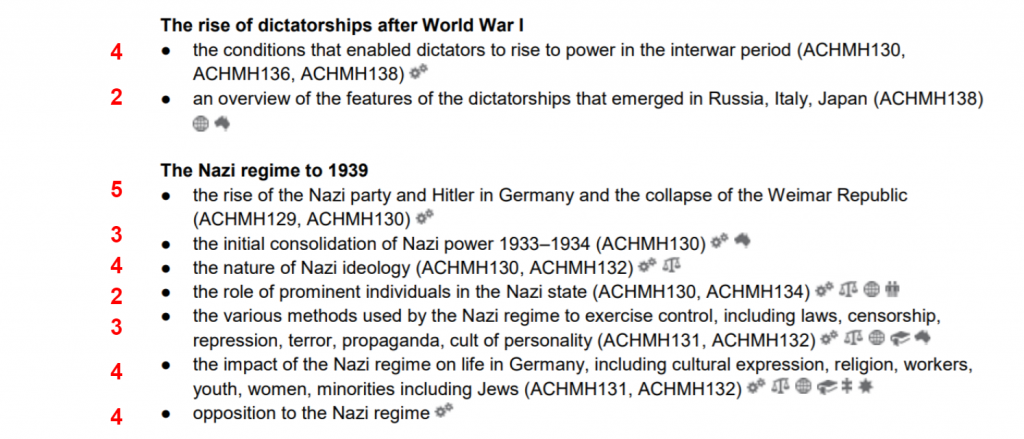
Step 2: Ensure your notes correspond with the Syllabus
Spend about 45 minutes going through your own notes or class notes and make sure they correspond to each dot point listed on the HSC Modern History syllabus.
Tick each syllabus dot point off as you’ve identified that you’ve covered them in your notes.
As you’re moving through, pay particular attention to areas that you rated less than 4 in your understanding and knowledge.
For each dot point check whether your notes include these key pieces of information:
- What is the key content for this dot point? List at least 3 facts.
- List at least 1 piece (ideal is 2) of historical evidence (e.g a quotation from a historian).
If you can answer these for the syllabus dot point, highlight it: this is what you need to revise.
Step 3: Start filling the gaps
Now that you’ve identified the areas of the HSC Modern History syllabus you are weak in and where you’ve got holes in your notes it’s time to start filling in the gaps.
Spend an hour converting each syllabus dot point you are weak in into a HSC question.
How?
It’s simple. Add a verb (if there isn’t one already) to the beginning of the dot point and a question mark at the end!
Here’s how you can do this:
So, for example, if I take the dot point from Core: Power and Authority in the Modern World:

Converted to HSC Style Question:
- Explain the features of the dictatorships that emerged in Russia, Italy and Japan post World War I.
Dot Point Answer
Respond to the question in dot point format. Make sure you do the following:
- What is the content for this dot point? List at least 3 facts.
- Provide at least 1 (ideal 2) pieces of historical evidence
If you haven’t kept on top of your study notes, now isn’t the time to be writing them or making them pretty but consolidating information of which you may not be so sure.
If you do need a bit of help figuring out how to get on top of your notes, check out our article on updating notes here!
Action Point:
- Print your your HSC Modern History syllabus
- Go through and so a self-rating, giving yourself a score of 0-5 for each dot point
- Go through your study notes and ensure they correspond with the syllabus. Ask yourself whether you’ve got 3 facts and at least 1 piece of historical evidence for each syllabus dot point
- For any dot points you’ve rated yourself weak in, or your notes aren’t up to scratch, convert the dot point into a HSC question and in dot point format respond making sure you cover 3 facts and 1 piece of historical evidence
Day 2: Core – Power and Authority in the Modern World 1919–1946
Step 1: Start on a Part I of a Practice Paper
This section of the paper should take you 45 minutes. Unfortunately, as the Modern History syllabus has changed recently, there are no past papers you can use.
For your first past paper, go through it under timed conditions – open book.
This means stick to the 45 minutes time limit strictly. You need to start getting comfortable with this.
Why open book? The first run through it to help you memorise and lock-in the correct content. Only check your notes when you absolutely need to!
When you’re done, have a go at marking your responses as honestly as possible.
Use the following rating when you’re marking as well:
- Silly mistakes
- Did not know the answer at all
- Misunderstood the question
- Incorrect knowledge
This way, you know what you’ll need to brush up on.
If you’re getting less than 21/25 you need to do some more revising!
Why the 21/25 threshold? This is 85% (roughly) – Section 1 is the easiest part of the paper so it’s critical you pick up as many marks as possible as you can here. The more the better!
Step 2: Revise Your Notes
For the areas you’ve identified as being wrong, go to the HSC Modern History syllabus and without looking at your notes (so look, cover, check style) ask yourself the same questions I’ve set out above.
- What is the key content for this dot point? List at least 3 facts.
- List at least 1 piece (ideal is 2) of historical evidence (e.g a quotation from a historian).
Answer these out aloud using your own knowledge.
When you’re done, look back to your notes – give yourself an honest rating of how well you did:
- 0/5 – No attempt, or completely incorrect
- 1/5 – Attempt made, but mostly incorrect
- 2/5 – Source listed but no correct fact provided OR correct fact provided by no source
- 3/5 – Sources listed but fact is erroneous OR sources are erroneous but fact is correct
- 4/5 – 2/3 sources are correct and substantiate the fact OR 3/3 sources are correct but fact is erroneous/incorrect
- 5/5 – All sources are listed and correctly substantiate the fact
Anything less than a 3/5 should be revised once more.
Pull out your study notes and re-write out the key content and evidence in dot point format x 3 quickly.
Don’t stress out if you’re not getting everything correct. Remember, you are marking yourself, and more often than not, we can be a harsher critic to ourselves than our markers!
Step 3: Complete a 2nd Practice Paper
Now choose another Practice Paper to complete in 45 minutes which you can again find here.
The goal for this 2nd paper is to really reinforce and lock the content in your mind as well as help you get comfortable responding to the source analysis questions in Section 1 (practice makes perfect!)
Go through the paper completely closed book this time. You want to mirror exam conditions as closely as possible.
10% Less Time Rule
In practice you want to give yourself 10% less time as this way, in the exam it will feel as though you’ve got lots of time! This will reduce the incidence of silly mistakes + give you more time for planning.
So, for this paper, give yourself 40 minutes (as opposed to 45 minutes) which is a little over 10% less time.
Mark your paper afterwards. Have you improved from your previous scores on the first paper Section 1 you complete?
Action Point:
- Complete Section 1 of a past HSC Modern History Practice Paper in timed conditions open book
- Mark your responses and if you’re scoring less than 21/24 in practice open book, revise!
- Revise by going through your notes, conducting a look, cover, check test, verbally testing yourself on 3 key facts and 1 piece of historical evidence per dot point
- Complete your 2nd HSC Modern History practice paper in timed conditions, closed book
- Give yourself 10% less time (so 40 minutes) for this paper.
- Mark the paper – have you got over the 21/25 threshold?
Day 3: National Studies
Today’s focus is on your national study and the big 25 mark essay. You’ll be given a choice of 2 essays, of which you’ll need to respond to one, worth 25 marks.
No pressure right!
The questions for HSC Modern History National Studies generally takes the form:
- To what extent is [this statement/fact] accurate?
- To what extent does [event/policy] affect [nation]?
- How significant was [fact/event/policy] for [nation/key event]?
- Assess impact/role of [policy] on [nation/key event]?
Given that this is generally what is asked, you want to make sure you’ve covered all of these styles of questions for your particular National Study.
However, specific focus must be placed on the Content Focus as outlined by NESA at the top of the syllabus for each National Study.
In fact, it lists ‘key features and issues’ where they draw the extended response themes from. So make sure you go through this and get familiar with it!
For example, the content focus and key features for the China study looks like this:
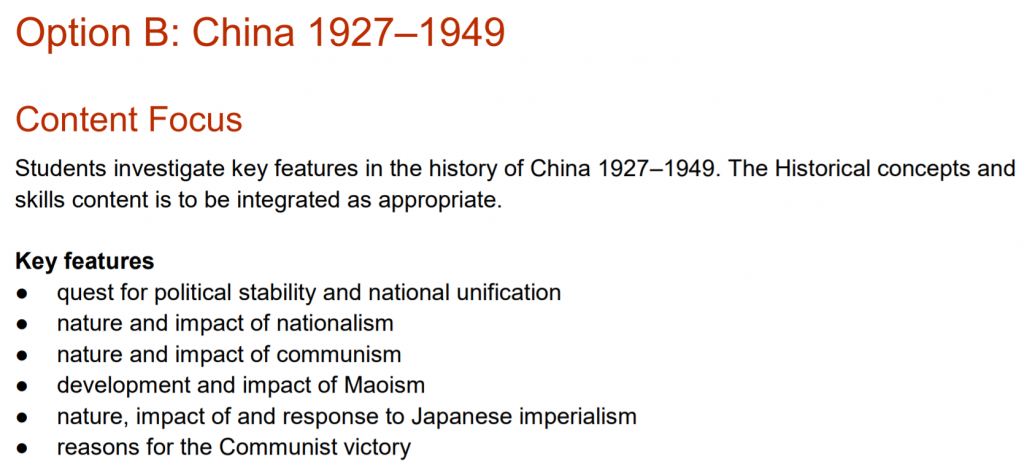
Make sure you also have a read of the Outcomes of the National Study, as prescribed by NESA:
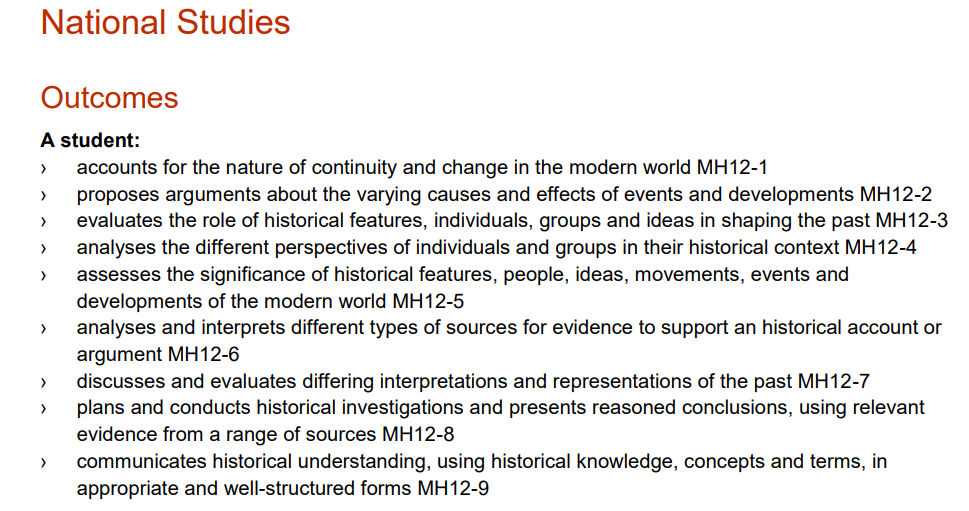
1. Revise Your Notes
While revising, ask yourself questions which shape themselves towards the key features of the dot point. For each dot point ask yourself one of the typical extended response questions listed above, connecting to the ‘key features’ of the principal focus in your syllabus.
For Example, Syllabus Dot Point:
- The Long March and its political and social consequences
Question:
- To what extent did the Long March in contribute to Communist victory in
China?
In dot point format, jot down any key points that come to mind. Anything that you cannot recall in less than 30 seconds of writing you’ll need to revise.
Rule of 3
Go through and complete this for your whole National Study. Revise by getting out your notes and writing out the key points in dot point format 3 times to lock it into your memory.
Why 3 times? From our research over the last 8 years with student’s who scored ATAR’s over 98, they shared that it typically took 3 times of re-writing out key points to really lock material into their memory.
2. Complete Section 2 of a Past Paper
National Studies have remained the same in the new syllabus. This means that Section 2 of the old HSC Papers are still valuable to practice with.
Start with Section 2 from the 2019 HSC Modern History Exam Paper here.
Mirror exam conditions and give yourself 45 minutes – although on your first run through do your paper open book so if you get stuck you can find the answer you need.
Remember, the goal on your first run through of a paper is to build strong knowledge rather than test your knowledge!
When you’re done, check it against the Marking Guidelines and give yourself an honest marking against the Guidelines (especially for the short answers and extended responses).
If you’ve scored less than 20 out 25 marks for Section 2, you’ll need to go back to revising in the step above!
3. Complete a 2nd Past HSC Paper – Section 2
Complete Section 2 from 2018 HSC Modern History Paper here.
10% Less Time
Once again give yourself 10% less time for this section. So 40 minutes as opposed to 45 minutes. Furthermore, complete this past question closed book, as the goal is to now start testing your knowledge.
Mark your work when you finish using the marking guidelines.
Did you score less than 20 out of 25? Go back and revise again!
Action Point:
- Get familiar with the principal focus and key features for your National Study from the HSC modern history syllabus
- Revise your study notes – for each dot point convert it into one of the 4 typical types of national study questions and connect it to a key feature in the syllabus
- Respond to it quickly in dot point format by writing
- Identify any key areas you’re struggling to respond to – allocate specific time to go through your notes on this, and re-write out the content x 3
- Complete Section 2 of the 2016 HSC Modern History Exam Paper here in 45 minutes. Mark yourself – if you give yourself less than 20/25, go back and revise repeating steps above.
- Complete Section 2 of the 2015 HSC Modern History Paper here in 40 minutes. Mark yourself – score less than 20/25? Go back and revise again!
Day 4: International Studies in Peace and Conflict
Today’s focus is on your International Studies in Peace and Conflict topic, and another big 25 mark essay. You’ll be given a choice of 2 essays, of which you’ll need to respond to one, worth 25 marks.
The questions for HSC Modern History International Studies in Peace and Conflict generally takes the form:
- To what extent is [this statement/fact] accurate?
- To what extent [event/policy] affect [international conflict]?
- How significant was [fact/event/policy] for [international conflict/key event]?
- Assess impact/role of [policy] on [international conflict/key event]?
Given that this is generally what is asked, you want to make sure you’ve covered all of these styles of questions for your particular International Studies topic.
However, remember to focus on the Outcomes and ‘Key Features’ that can be found in the syllabus:
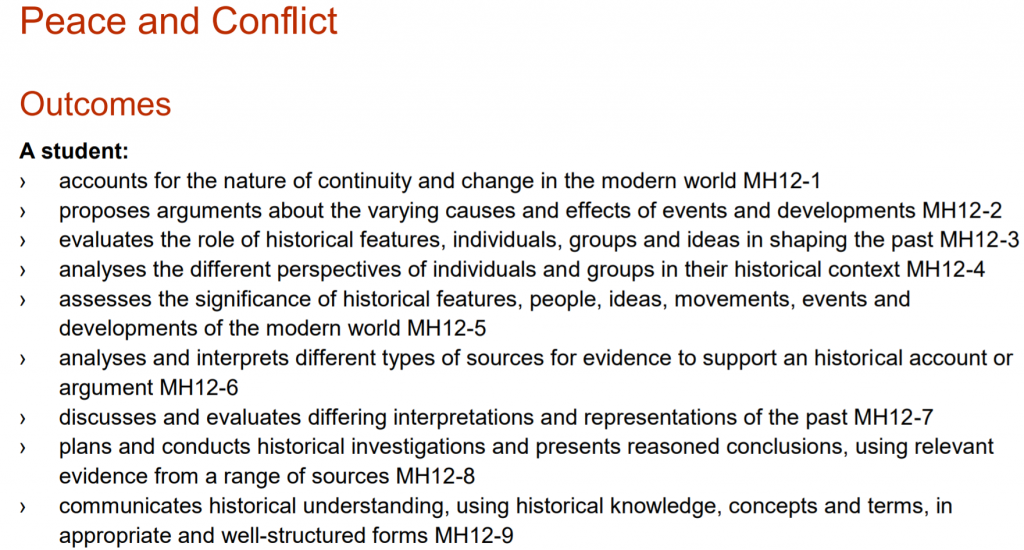
Step 1: Revise Your Notes
Like with the National Study and Peace/Conflict Study, ask yourself questions based on your notes, which should shape themselves towards the key features of the dot point.
The questions in this section will test your knowledge as well as require you to make judgements about the period. You may also be asked to assess an existing interpretation of the period, so be prepared to make arguments about the content you have learnt.
For example, if you are studying ‘Option D: The Cold War 1945-1991’ and you’re going through the section ‘Renewal and end of the Cold War’ for each dot point ask yourself a question that requires a judgement in the answer- if possible link this question to the Syllabus outcomes or key features of the option.
For example:
Syllabus dot point:
- Soviet attitudes and policies under Gorbachev
Question:
- To what extent did Soviet policies under Gorbachev contribute to the end of the Cold War?
Jot down in dot points any key points that come to mind. Anything that you cannot recall in less than 30 seconds of writing you’ll need to revise.
Rule of 3
Go through and complete this for your Peace and Conflict option you have studied. Write down the key pieces of information and evidence for each dot point.
Repeat this three times.
Step 2: Complete Section 4 of a Past Paper
The Peace and Conflict study has also remained from the pre-2019 syllabus, meaning that you can use an old practice paper here!
Mirror exam conditions and give yourself 45 minutes – On this first run through do your paper open book so if you get stuck you can find the answer you need.
The goal on this first practice essay is to build strong knowledge and practice responding to a question.
When you’re done, mark your essay against the marking guidelines.
If you’ve scored less than 20 out 25 marks for Section 2, you’ll need to go back to revise, by repeating the step above!
Step 3: Complete a 2nd Past Paper
Complete another practice essay. Once again give yourself 10% less time for this section and try to write your essay within 40 minutes.
This time complete the essay closed book, to test your knowledge of the syllabus. Mark your work when you finish using the marking guidelines.
Did you score less than 20 out of 25? Go back and revise again!
Action Point
- Get familiar with the principal focus and key features for your International Study from the HSC modern history syllabus
- Revise your study notes – for each dot point convert it into one of the 4 typical types of International Study questions and connect it to a key feature in the syllabus
- Respond to it quickly in dot point format by writing
- Identify any key areas you’re struggling to respond to – allocate specific time to go through your notes on this, and re-write out the content x 3
- Complete a practice essay, within 45 minutes. Mark yourself – if you give yourself less than 20/25, go back and revise repeating steps above.
- Write another practice essay, this time within 40 minutes. Mark yourself – score less than 20/25? Go back and revise again!
Day 5: Change in the Modern World
Today’s focus is on the new topic, Change in the Modern World, which is examined in the HSC through a series of short answer and extended response questions.
The section has a total of 25 marks, and will consist of 3-4 questions.
Check out this article for tips on how to ace the Change in the Modern World questions!
Remember to focus on the Outcomes and ‘Key Features’ that can be found in the syllabus, as questions will be based on these, as well as the syllabus of your chosen topic.
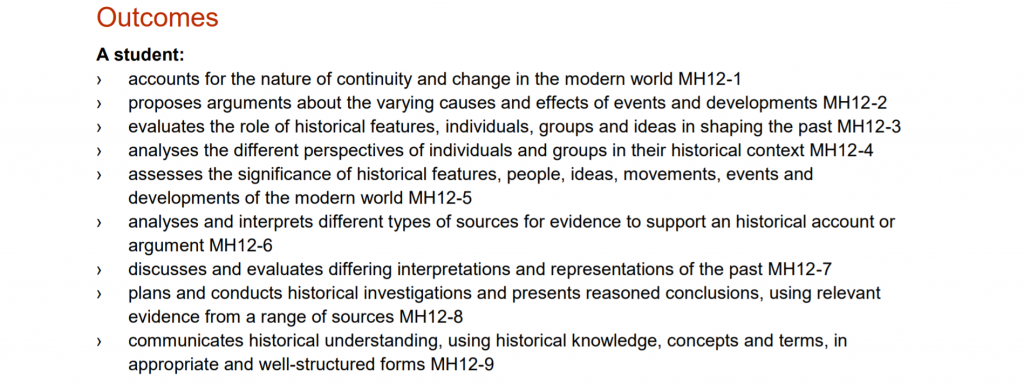
1. Revise Your Notes – 60 minutes
Like with the National Study, ask yourself questions based on your notes, which should shape themselves towards the key features of the dot point.
For example, if you are studying ‘Option F – The Cold War 1945-1991’ and you’re going through the point ‘1.Origins of the Cold War 1945–1953’, for each dot point ask yourself one of the typical extended response questions listed above, connecting to the ‘key features’ of the Principal Focus in your syllabus.
Syllabus Dot Point:
- 1945 conferences and the emergence of the superpowers
Question:
- To what extent did the 1945 conferences and the emergence of the superpowers play a role in the development of the Cold War?
Jot down in dot points any key points that come to mind. Anything that you cannot recall in less than 30 seconds of writing you’ll need to revise.
Rule of 3
Go through and complete this for your whole Change in the Modern World syllabus. Revise by getting out your notes and writing out the key points in dot point format 3 times to lock it into your memory.
Step 2: Complete Section 4 of a Practice Paper
As this is a brand new topic from 2019, there is currently only one past paper available which you can access here!
However, you can access two Art of Smart Practice Papers for Change in the Modern World here!
Mirror exam conditions and give yourself 45 minutes – On this first run through do your paper open book so if you get stuck you can find the answer you need.
The goal on this first practice essay is to consolidate your knowledge of the topic and practice responding to different types of questions.
The NESA Sample paper, from page 51, provides marking criteria for answers to the sample questions. Use this as a guide for assessing your own answers.
If you’ve scored less than 20 out 25 marks for Section 2, you’ll need to go back to revise, by repeating the step above!
Step 3: Complete a 2nd Practice Paper – Section 4
Complete another practice section. Once again give yourself 10% less time for this section and try to complete the questions within 40 minutes.
This time, answer the questions closed book, to test your knowledge of the syllabus.
Mark your work when you finish using the marking guidelines.
Did you score less than 20 out of 25? Go back and revise again!
Action Point:
- Get familiar with the principal focus and key features for your Change in the Modern World Study from the HSC Modern History syllabus
- Revise your study notes – for each dot point convert it into one of the 4 typical types of International Study questions and connect it to a key feature in the syllabus
- Respond to it quickly in dot point format by writing
- Identify any key areas you’re struggling to respond to – allocate specific time to go through your notes on this, and re-write out the content x 3
- Complete a practice section, within 45 minutes. Mark yourself – if you give yourself less than 20/25, go back and revise repeating steps above.
- Complete another practice section, this time within 40 minutes. Mark yourself – score less than 20/25? Go back and revise again!
Day 6: Fine Tuning
Step 1: Identify problem areas
Skim the entire HSC Modern History syllabus, identify your problem areas, and focus on perfecting those in time for the exam. Struggling with your National Study? Dedicate most of your spare time to that. Bemused by your International Study?
Go back and convert each syllabus dot point into a question, using the principal focus, key features, and typical question types as a guide. Respond to each question quickly in dot point format.
Step 2: Have a break
Give yourself a 20 minute breather and get yourself prepared to do a practice exam.
Step 3: Revise notes
You’re standing outside the exam room for your HSC Modern History exam and you’ve got twenty minutes to look over your problem areas.
Ask yourself challenging questions and give yourself 100% answers.
Go back and ask yourself the 2 vital questions in the ‘look – cover – write – check’ style.
Step 4: Practice exam
Putting together a practice paper for the new syllabus will be a bit like completing a jigsaw puzzle.
You can use an old HSC Exam for the National and Peace/Conflict Studies, but will need to also have the sections for the Core Study and Change in the Modern World ready to use for your practice exam.
Day 7: Last Minute Preparation
The goal from the day before is to do the following:
- Reinforce the content in your memory
- Complete as many practice essay/extended response plans for all possible questions
Here’s a 5 step plan for doing this:
Step 1: Get out your study notes
Get your study notes out and re-write out 3 key points + 1 piece of historical evidence (e.g quote) for each dot point. Do this 3 times following the rule of 3.
Step 2: Complete 3 past papers in dot point format
So, go through them and rather than write complete essays, just write the answers in dot point.
The goal here is to help you apply your knowledge and work out how to respond for typical questions. Do this closed book.
Step 3: Mark your papers
Anything you’ve got wrong, revise. Get a family member of friend to quiz you on the syllabus dot point and teach them
Step 4: Get to sleep early
Studies reveal that even 90 minutes of lost sleep can reduce your cognitive performance by 33% the next day!
Step 5: Avoid studying your notes the morning before the exam
The reality is if you haven’t learned the content by then, you’re not going to learn it in time.
All reading your notes will do is tell you what you don’t know. And all that will do it freak you out!
What to do now?
I hope this HSC Modern History study plan has helped you to plan your week before the Modern History exam.
Remember to keep calm and take a second to think about what the question is truly asking instead of rushing in blindly.
Best of luck and don’t forget to check out our other subject 7 day study guides!
- 7 Day Study Plan – HSC Standard & Advanced English
- 7 Day Study Plan – HSC Legal Studies
- 7 Day Study Plan – HSC Biology
- 7 Day Study Plan – HSC Ancient History
- 7 Day Study Plan – HSC Economics
- 7 Day Study Plan – HSC Chemistry
Looking for some extra help with HSC Modern?
We have an incredible team of HSC Modern History tutors and mentors who are new HSC syllabus experts!
We can help you master the HSC Modern History syllabus and ace your upcoming HSC Modern assessments with personalised lessons conducted one-on-one in your home or at our state of the art campus in Hornsby!
We’ve supported over 5,000 students over the last 10 years, and on average our students score mark improvements of over 19%!
To find out more and get started with an inspirational HSC Modern History tutor and mentor, get in touch today or give us a ring on 1300 267 888!
Milana Gusavac is thought she had seen the end of HSC until she realised that others out there needed help surviving year 12 just like she had. Now she’s a member of the Art of Smart team while perusing her studies at the University of Sydney, studying a Bachelor of Psychology. When not learning or helping other’s Milana can be found with her nose in a book or marathoning TV shows.
Yifan Shen completed his HSC in 2014 and is currently studying the Bachelor Of Economics/Advanced Mathematics at UNSW. Apart from nutting out equations and helping out students with their academic pursuit, you will find him either reading thriller novels or introducing a range of new people to the intricate and mysterious world of mathematics as the marketing representative of UNSW MathSoc. When he is drained from all of these work, you will also see him hiking, planking and water bending in his recovery mode.


